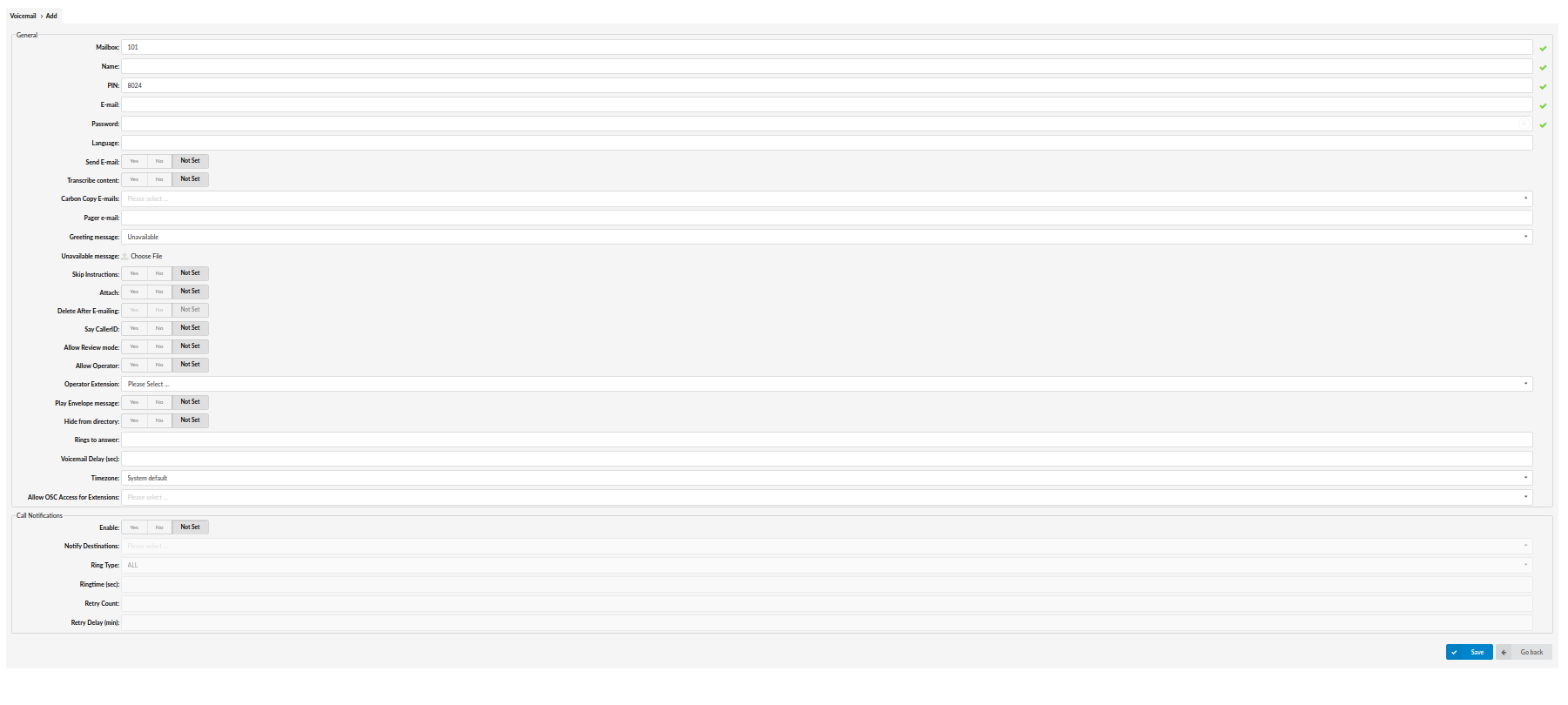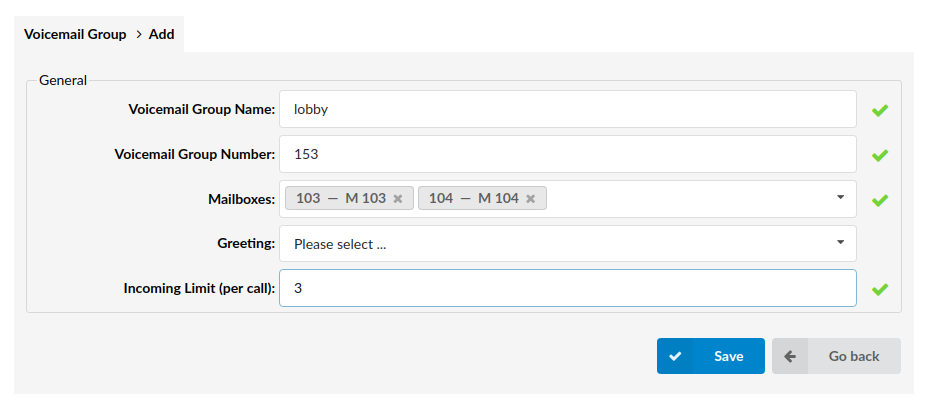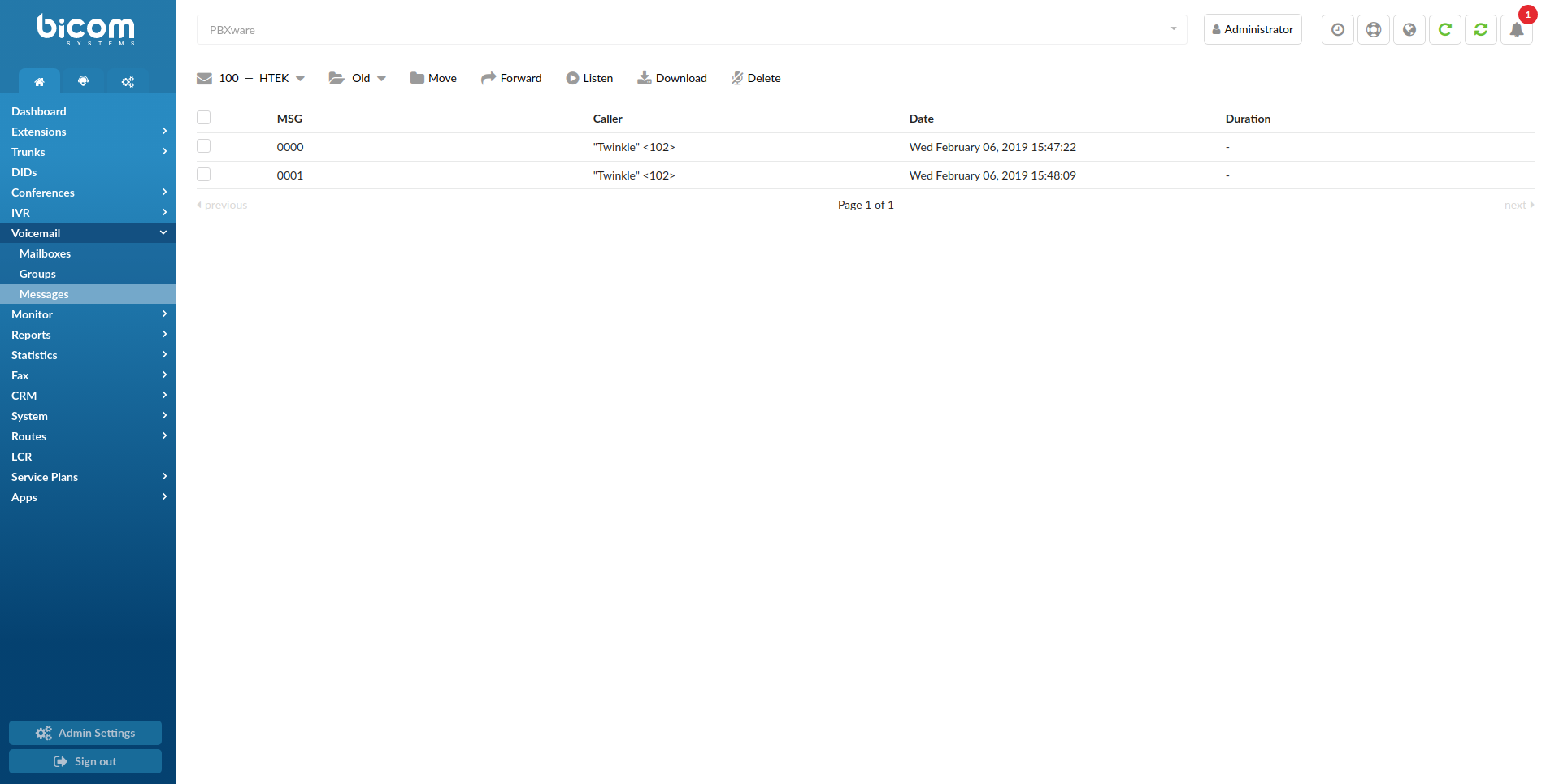PBXware voicemail is an advanced answering machine. Although each extension is equipped with a voice mailbox, voice mailboxes can be created on their own as well from this location.

¶ Mailboxes
NOTE: We have lockout feature for Voicemails. It is directly related to the 'Max login attempts' option meaning that if a user fails to enter their voicemail PIN correctly after E.g., 3 tries, that voicemail will be blocked until an administrator unblocks it.

This screen lists all system mailboxes with the following details:

- Name:
Full name of the voice mailbox user/extension name.
(E.g. Peter Doyle)
(Display)
- Mailbox:
Voice mailbox extension number.
(E.g. 1006)
(Display)
- Domain:
Domain/Context voice to which the mailbox belongs.
(E.g. default)
(Display)
 Edits the voice mailbox configuration
Edits the voice mailbox configuration
(Click to edit the voice mailbox configuration)
NOTE Edit command will be disabled for users with the system extension. Their voicemail settings are edited via self care or by editing their extension.
(Button)
 Deletes a voice mailbox account from the system
Deletes a voice mailbox account from the system
(E.g. Click to delete a voice mailbox from the system)
(Button)
Voice Mailbox Access
In order to access custom voice mailboxes from any PBXware extension, dial *124.
After you hear the "Comedian mail mailbox" message, enter $VOICE_MAILBOX_NUMBER', then you will be prompted to enter the PIN for that extension (PIN can be found in Extension -> Edit -> Authentication -> PIN) or a Mailbox in case you have created mailbox on its own (Voicemail -> Mailboxes -> Edit -> PIN).
After typing PIN number you will hear and you will be offered the following:
You have x new/old message
(x is the number of new or your old messages)
- Press 1 for new /old messages
(Gives the information about time, date and from which number the voicemail was sent.)
- Press 2 to change folders
Change to which folder:
Press 0 for new messages,
Press 1 for old messages,
Press 2 for work messages,
Press 3 for family messages,
Press 4 for friends messages,
Press ‘#’ to cancel
- Press 3 for advanced options
Press 4 to place an outgoing call,
Press 5 to leave a message,
Press '*' to return to the main menu
- Press 0 for mailbox options
Press 1 to record your unavailable message,
Press 2 to record busy your message,
Press 3 to record your name,
Press 4 to record your temporary greeting,
Press 5 to change your password,
Press '*' to return to the main menu
- Press ‘*’ for help
(Repeats the whole menu again.)
- Press ‘#’ to exit
¶ Search

Search
This option enables searching and finding desired mailboxes in a short amount of time.
Clicking on the ‘Search’ field users will be given the ability to type a search phrase.
Search can be done by entering:
- Extension name
- Extension number / Mailbox
- E-mail of the extension and by the Email of the mailbox user
¶ CSV upload
This option enables users to add a number of mailboxes real quick. Segments in the .csv file need to be comma-separated and in the following order: Mailbox number,name,PIN,E-mail.
¶ Download CSV Template
This option gives users the ability to download the CSV file template which makes creating a number of mailboxes even faster and easier.
¶ Add/Edit Voicemail
¶ General
Clicking on 'Add Voicemail/Edit Voicemail' will open the voicemail screen shown below.

Add/Edit Voicemail
- Mailbox:
Unique network voice mailbox extension number.
(E.g. Set this field to 5001, for example. Now, in order to dial into this voice mailbox, simply dial 5001 from any PBXware extension)
([0-9])
- Name:
Full name of the voice mailbox owner.
(E.g. John Smith)
([a-z])
- Domain:
Domain/Context this voice mailbox belongs to.
(E.g. This is an advanced feature. Leave this field set to 'default' unless you know what you are doing)
([a-z][0-9])
- PIN (Personal Identification Number):
Four-digit number used for voice mailbox authentication.
(E.g. Each voice mailbox has a unique PIN. In order to login to your voice mailbox, provide this number when asked for it by the operator e.g. 1947)
([0-9])
- Email:
Email address associated with the voice inbox. This email is used for a new voice message notification and audio file attachments.
(E.g. If 'john@domain.com' is set here, once this mailbox receives a new message, notification and the attached voice message (depending on if this option is enabled) will be sent to this email address)
([a-z][0-9][@_-.)
- Password:
This password will be used for OSC Voicemail login.
Password has to meet the following criteria:
- At least 8 characters long
- At least 1 uppercase letter
- At least 1 lowercase letter
- At least 1 digit
- At least 1 special character (! % * _ -)
Allowed characters are: a-z, A-Z, 0-9, ! % * _ -.
- Language:
If you installed additional language sound files on the system, you can choose a different language to be used for sound files related to voicemail.
(E.g. If you installed French language files in the sounds/fr folder, put 'fr' here to play French sound files when answering voicemail)
([a-z])
- Send E-mail:
Whether or not to send an e-mail to the address given above.
(Option buttons)
- Transcribe content:
Voicemail transcription is a service that converts audio voicemail messages into text format, which is then sent to the user via email or text message. It is sometimes referred to as ‘speech to text’, ‘voice to text’ or ‘voicemail to text’.
(Option buttons)
- Carbon Copy E-mails:
Add additional E-mail addresses to which you want voice inbox to be associated with.
- Pager e-mail:
Provide the pager e-mail address here.
(E.g. If 'john@pager.com' is set here, once this mailbox receives a new message, a notification is sent to this pager email address)
([a-z][0-9][@_-.])
- Greeting message:
Greeting message played to users before they are transferred to the voice mailbox to leave a message.
(E.g.Mailbox user may choose between a 'Busy' and 'Unavailable' message)
(Select box)
- Unavailable/Busy message:
Upload the custom unavailable message. The unavailable message supports: WAV, wav, and gsm files only.
(E.g. If the default unavailable message does not suit your needs, click the 'Browse' button, upload a custom message, and select it under 'greeting message')
(Select box)
- Skip instructions:
Skip the instructions telling users how to leave a voice message.
(E.g.Once the caller reaches the voice mailbox, instructions on how to leave voice message are played. You are encouraged to set this option to 'Yes' all the time)
(Option buttons)
- Attach:
Whether the voice message should be attached and sent along with the notification email.
(E.g. A caller leaves a voice message for John. With this option set to 'Yes', E-mail which notifies John about the voice message also has that voice message attached to it, so John can listen to the message without having to sign into his voice mailbox.))
(Option buttons)
- Delete After E-mailing:
Whether the voice message sound file should be deleted from the filesystem after sending it as an attachment to the user's email address.
(E.g.The caller leaves a voice message to John. With this option set to 'Yes', the voice message will be deleted after sending it as an attachment to John's email address)
(Option buttons)
NOTE: In order for this option to be available, you need to set ‘Attach’ option to ‘Yes’ which will enable sending voice message as an attachment in mail.
- Say CallerID:
Whether the extension number which left the voice message should be announced to the mailbox owner.
(E.g. With this option set to 'Yes', John will hear '... from phone number 1004...' when checking his mailbox, for example).
(Option buttons)
NOTE: If you leave this option as ‘Not Set’, by default CallerID will be announced to the mailbox owner.
- Allow Review mode:
Allow the user to review his voice message before committing it permanently to the voice mailbox.
After a caller leaves a voice message and presses ‘#’, additional options will be offered:
Press 1 to accept this recording
Press 2 to listen to it
Press 3 to re-record your message
Press 4 to mark this message as urgent.
(Option buttons)
- Allow Operator:
Allow the caller to reach the operator from the voice inbox by pressing '0'. Once the user leaves a voice message and presses ‘#’, additional option '...press 0 to reach an Operator', will be heard.
If no ‘Operator Extension’ in the field below is written, by pressing 0 call will be finished.
NOTE: Voice message recorded before pressing 0 will be deleted from the system.
(Option buttons)
- Operator Extension:
If ‘Allow Operator’ option in the field above is set to ‘Yes’, the caller will be given an option to press 0 to reach an operator.
Choose the Operator Extension from dropdown here.
(E.g. Once the caller leaves a voice message to John and presses '0' to reach the Operator, the extension number provided here (e.g. 1001) will be dialed)
NOTE: Voice message recorded before pressing 0 will be deleted from the system.
([0-9])
- Play Envelope Message:
Announces the date and time when the voice message was left in the inbox.
(E.g. With this option enabled, John will hear 'First message, 11:52, 02 Feb 2007', for example, when checking his voice mailbox)
NOTE: If you leave this option as ‘Not Set’, by default date and time when the voice message was left in the inbox will be announced to a mailbox owner.
([0-9])
- Hide from directory:
This option will allow you to hide your voicemail extension from the directory list.
(E.g. Yes, No, N/A)
(Option buttons)
- Rings to answer:
Number of rings played to the caller before the call enters Voicemail.
TIP: Rather than just 'falling' into Voicemail, it is recommended to set the number of ring sounds played to the caller.
NOTE: By default, this field is empty which means that there will be no ringing. The caller will 'fall' into Voicemail immediately after calling.
([0-9])
- Voicemail Delay (sec):
The time delay in seconds before the Busy/Unavailable message is played to the caller. This solves the 'half-played' file problem. Keep this value between 1-3.
(E.g. The caller is leaving a voice message to John. It hears '...not at home right now...'. Adding '1' to this field will add a one-second pause before the message is played. So, now the caller will hear the greeting message without the first part being cut off 'I am not at home right now...').
([0-9])
- Timezone:
Set the correct date and time format for the message envelope. Timezones are taken from the '/usr/share/zoneinfo' system directory.
(Select box)
- Allow OSC Access for Extensions:
A list of extensions that will be allowed to view this mailbox from their OSC in the Voicemail section.
(Select box)
¶ Call Notifications
- Enable:
If this specific inbox should use call notifications or not.
(E.g. Yes, No, Not Set)
(Option buttons)
NOTE: This option is mutually exclusive with the delete after E-mailing options.
- Notify Destinations:
Extensions to be called when a voicemail is received. Choose the Notify Destination from dropdown here.
- Ring Type:
You can choose here ALL or SINGLE. It indicates how many extensions are rung at a time.
- Ringtime (sec):
How long to ring each target (default 32).
- Retry Count:
How many times to retry if none accepts on the first try (default 0).
- Retry Delay (min):
How many minutes to wait for the next retry after the last one failed (default 1).
- Retry if not accepted (6.7.5)
When the option is set to "Yes," the destination set under “Notify Destination” will be dialed and presented with IVR options:
1 - to listen to the voicemail
2 - to refuse to listen to the voicemail
3 - to play the called ID
In order to stop the notification calls user will have to listen to the voicemail. In case the user drops the call or selects any option other than '1,' the notification call will be repeated until voicemail is listened to by selecting option '1.'
The calls will be repeated at intervals specified in the "Retry Delay" setting.
The default setting with the option set to N/A is No.
¶ Groups
Voicemail groups are used to group voicemail inboxes. Once a voice message is left to group 2002, for example, all destinations that belong to that voicemail group will receive the same voice message. This screen lists all system voicemail groups with the following details:

- Group Name:
Voicemail group name/identifier
(E.g. Lobby)
(Display)
- Group number:
Voicemail group number. Once dialed, the voicemail message will be left to all 'Destinations' of the voice boxes in this group
(E.g. 2002)
(Display)
- Mailboxes:
Numbers of Mailboxes assigned to a Voicemail Group.
(E.g. 1001, 1002, 1003)
(Display)
 Edits the voicemail group configuration
Edits the voicemail group configuration
(E.g. Click to edit the voicemail group configuration)
(Button)
 Deletes a voicemail group from the system
Deletes a voicemail group from the system
(E.g. Click to delete a voicemail group from the system)
(Button)
¶ Add/Edit Voicemail Group
- Voicemail Group Name:
Voice mailbox network name.
(E.g. Create a voicemail group, 'Lobby', for example)
([a-z][0-9])

Add/Edit Group
- Voicemail Group Number:
Voicemail Group number.
To leave a message to this group mailbox, callers will have to dial the extension number set here, e.g. 2002)
([0-9])
- Mailboxes:
A list of mailboxes that belong to this voicemail group is set here.
To assign extensions to this voicemail group, provide their extension numbers separated by a comma ',' here. For example, 1001,1002,1003...)
([0-9])
- Greeting:
The greeting which is played when calling this Voicemail group.
Note: When uploading a greeting for the Voicemail group, the name of the sound file must start with 'vm-greeting'.
(Select box)
- Incoming Limit (per call)
The maximum number of times each call can enter the Voicemail group. Entering a value in this field will prevent eventual infinite loops that might be accidentally set up on the system.
¶ Messages
This section gives users a preview of all of their Voicemail. Users first need to select the desired Mailbox and then they will be introduced with Voicemails that Mailbox contains.

Messages
Following information is given:
Check Box
Check box allows users to choose which Voicemail they want to work with. There is an option to choose one, multiple or all Voicemails.
After choosing, users can manipulate voicemails with the following options that can be found above the Voicemail list:
- Move
- Forward
- Listen
- Download
- Delete
MSG
Gives users the information about the position of Voicemail in Mailbox. Lower the number the older it is.
Caller
Information about the caller. If the caller has set the Caller ID users will see “CallerID”. If the CallerID is not set the user will see “Extension name”.
Date
Date and time when the Voicemail was sent.
Duration
The length of a Voicemail.
¶ Search Voicemail

Mailbox name
By clicking on this field, the drop-down menu will be presented to users allowing them to decide which Mailbox they want to see. Users will only see Voicemails that belong to the chosen Mailbox.

Inbox
This field allows users to search Voicemails by folders in Mailboxes.
¶ Voicemail options
After selecting desired Voicemails users have the ability to manipulate them with the following options:
- Move
Moves Voicemail to the desired folder. This option enables faster search and a more organized Mailbox.
- Forward
Forwarding Voicemail to another extension. After choosing Voicemail and clicking Forward users will be asked to enter the extension number of an extension to which they want to forward a Voicemail.
- Listen
By clicking on this field, users will have the ability to listen to Voicemail recordings.
- Download
After selecting Voicemail, click here to download the recording.
- Delete
After selecting Voicemail, click here to delete the recording.